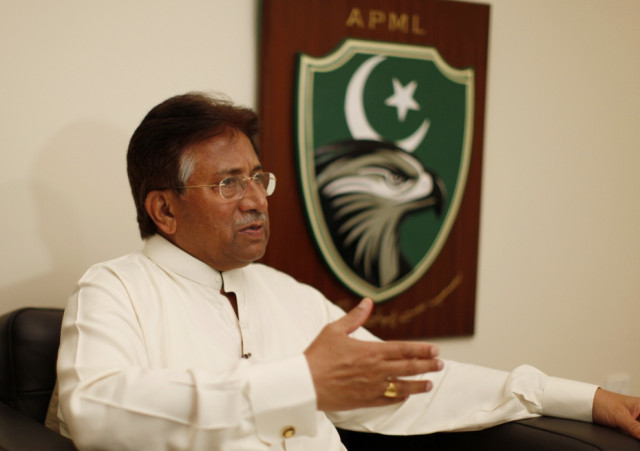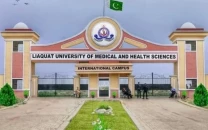High treason trial: The case of the missing dossier
Ex-interior secretary Kamal Shah allegedly asked Musharraf to impose emergency.

A secret dossier suggesting that General (retd) Pervez Musharraf impose martial law to counter the “negative impact of judicial activism” in 2007 has gone missing from the official records of the high treason case.
Requesting anonymity, a senior level government official told the Express Investigation Cell (EIC) that the missing document sent by former interior secretary Syed Kamal Shah had been a “hot button” issue during the Federal Investigation Agency’s (FIA) investigations into the high treason case. More than one of the authors of the dossier, including Shah, was specifically questioned by investigators.
“Since the dossier [of Syed Kamal Shah] is the key document in the investigation into the case, its availability had extraordinary significance for investigators to ascertain who was in the consultation process of the post-2007 emergency. In the same context, different characters of the case were inquired about it during the investigation process” an investigator said.
Shah acknowledged that FIA investigators had summoned and questioned him in the high treason case, but he denied handing any such document to Musharraf as interior secretary.
He also denied that he was specifically inquired about this dossier.
Officials disclosed that the investigators “sharply differed” with Shah over the issue and expressed concern that Shah, a close and trusted member of the Musharraf team, had given the dossier at the camp office of the president at a rare meeting.
More than one participant at the meeting confirmed to the FIA that the dossier was handed at the camp office meeting where the former prime minister held most meetings as part of his consultative process before imposing emergency in the country.
An official of the investigation agency on the condition of anonymity said that the issue of the missing dossier had remained under discussion during the investigation process and was referred to in the inquiry report submitted to the interior ministry last month.
Officials also said that Musharraf had held a series of meetings for two weeks to review the situation arising out of the friction between the Shaukat Aziz-led government and the senior judiciary over issues like the sale of Pakistan Steel Mills and that Shah gave the dossier at one such meeting.
Participants of the meetings included four governors, chief ministers, Syed Kamal Shah, principal secretary to the president, Mohsin Hafeez, then cabinet secretary Syed Masood Alam Rizvi, former law secretary Justice (retd) Ajmal Mian and top legal and constitutional aides to Musharraf, which indicate the importance of the huddles.
In a recent interview with Express News programme Acha Lagay ya Bura Lagay, Ch Shujaat Hussain confirmed that there were others on board as well in the decision impose emergency. He also confirmed that he supported the emergency but advised Musharraf to exclude the judiciary.
The FIA team had questioned over two dozen top government functionaries and close aides to Musharraf who directly or indirectly had a role in the imposition of the 2007 emergency. The team also recorded statements of former governors and chief ministers to determine whether Musharraf really consulted with other power brokers before imposing emergency in the country. Shaukat Aziz, then prime minister, was time and again informing Musharraf in writing and in person that as long as Iftikhar Chaudhry and “like-minded judges” were holding office, his government will remain in trouble. He had also written a secret letter to Musharraf demanding that he get rid of senior judges, including Chaudhry to rule as per his wishes.
His letter is now part of the FIA report submitted to the interior ministry in the high treason case against Musharraf.
Taking line from Shaukat Aziz’s “consultation”, Musharraf had filed a reference with the Supreme Judicial Council (SJC) against Iftikhar Chaudhry in April 2007. The SJC had rejected the reference calling it mala fide and unlawful.
The rejection of the reference added to the concerns of Musharraf and Aziz, who then opted for an out-of-the-box solution to tackle the ‘crisis’.
After weighing different ‘suggestions’, like the one given by Shah, Musharraf finally imposed emergency in the country on November 3, 2007.
As a result, senior judges including former CJP Iftikhar Chaudhry were deposed and later put under house arrest. This action provoked lawyers who started a countrywide campaign for the restoration of the deposed judges.
Since Shah’s alleged dossier is of prime importance for the high treason trial, FIA investigators wanted to get its original copy before submitting the report to the interior ministry. However, the report was hurriedly submitted on November 15.
Investigators are convinced that someone removed the dossier from the official record to avoid a fallout at a later stage.
Published in The Express Tribune, January 1st, 2014.


















COMMENTS
Comments are moderated and generally will be posted if they are on-topic and not abusive.
For more information, please see our Comments FAQ